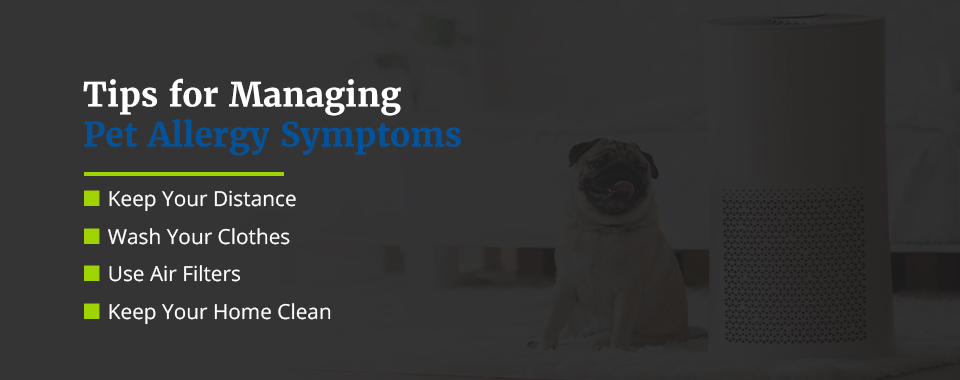
Many households have pets, from cats and dogs to birds, rabbits, lizards, snakes, mice, hamsters or more exotic animals. Pets have countless benefits — they can improve your health and happiness. Most see their pets as valued family members. Unfortunately, many people struggle with pet allergies, causing symptoms that range from uncomfortable to life-threatening. Pet allergies are a common cause for complaint, induced by your body’s reaction to pet urine, saliva or dander. These symptoms can be highly restricting, limiting your ability to have pets and your ability to visit homes with pets.
Table of Contents
- Signs of a Pet Dander Allergy
- Tips for Managing Pet Allergy Symptoms
- How to Treat Pet Dander Allergies
- Contact Houston Sinus & Allergy
If you experience pet allergies, you can take plenty of steps to relieve your symptoms. Several methods will help you avoid allergic reactions, manage their symptoms or decrease your allergy sensitivity. If you take the right measures, you can reduce or even eliminate your symptoms, allowing you to have pets. Learn all about pet allergy treatment and management.
Signs of a Pet Dander Allergy
Pet allergens cause telltale symptoms. The immune system reacts to the foreign substances in pet urine, saliva or dander. Despite common belief, no pets are truly hypoallergenic — even hairless pets produce allergy-inducing proteins. If you experience some of the following symptoms, you may have pet allergies:
- Inflamed, itchy eyes.
- Scratchy throat.
- Stuffy nose.
- Sneezing.
- Coughing.
- Shortness of breath.
- Red skin rashes or hives.
- Asthma episodes.
These symptoms may appear right away or after several days, depending on the severity and your sensitivity. You need not come in direct contact with an animal to experience an allergic reaction — pet allergens can sit on clothing, furniture or carpet fibers. They can even hang suspended in the air. In mild cases, allergic reactions may be hardly noticeable. In severe cases, allergic reactions can be life-threatening.

Tips for Managing Pet Allergy Symptoms
Several methods will help you manage your pet allergy symptoms. Use these strategies if you experience dog allergies, cat allergies or allergic reactions to any other household pets. Remember, no plan will erase all your symptoms.
Keep Your Distance
The best strategy for limiting your pet allergy symptoms is avoiding contact with those animals. Doing so can be challenging if you have a pet in your home, but you can take steps to reduce your contact with allergens. You might want to restrict pet access to rooms you often occupy or specific pieces of furniture.
Remember, these strategies will not eliminate all allergens, which can travel throughout the house. Try keeping allergy-inducing pets out of your home if you can help it. Even if you keep your home pet-free, a cat or dog allergy can be challenging to manage, since so many people have these pets. If avoidance is not possible, try other allergy-management strategies.
Wash Your Clothes
After exposure to pet allergens, you’ll need to change and wash your clothes. These particles can stick to your clothing and continue to aggravate your symptoms days after exposure. It’s crucial to wash your clothes as soon as possible to limit allergens dispersing in your home.
Use Air Filters
Air purification filters can help reduce symptoms by removing allergy-inducing particles from the air. Seek high-efficiency particulate air filters. Even if you have no allergy issues, HEPA filters can improve indoor air quality, promoting health and comfort. Well-maintained indoor air quality can reduce both short-term and long-term health effects, including respiratory and heart diseases. If you and your family spend most of your time indoors, it’s essential to promote clean indoor air for a healthy living environment, regardless of allergy symptoms. In addition to using air filters, you can improve ventilation by opening windows and using fans.
Keep Your Home Clean
It’s always helpful to keep your home tidy and clean. If you have carpets, you’ll need to vacuum often, as allergens can accumulate in carpet fibers. Wipe down surfaces and wash fabrics. You might want to wear a face mask and gloves as you clean, as allergens will release into the air. Regular cleaning will also help reduce other common allergens, including dust mites, mold and pollen.
How to Treat Pet Dander Allergies
Though avoiding allergen exposure is an effective way to reduce symptoms, it’s not always an option. If you experience pet allergy symptoms, you might want to consider some of the following allergy treatment options for pet dander relief. Consult with a health professional before starting any allergy-control treatments. Each solution has possible side effects to consider.
Antihistamines
Histamines are signaling molecules, essential for many bodily functions. They help the immune system protect the body against foreign substances. Histamines may detect pet proteins as dangerous foreign substances, triggering a response. When your immune system releases histamines, you experience allergy symptoms. Antihistamines block or reduce histamine production, thus limiting allergic reactions. They come in many forms, including:
- Capsules.
- Tablets.
- Liquids.
- Eye drops.
- Nasal sprays.
Decongestants
If you struggle with allergy-related congestion, which can cause difficulty breathing, decongestants can help. Congestion occurs when blood vessels in the nasal passages and airways swell up. Decongestants narrow those blood vessels to reduce swelling and inflammation. These can come in the form of oral tablets or liquids, as well as nasal sprays.
Allergy Shots
Allergy shots are a form of immunotherapy. Immunotherapy is more effective than other methods, addressing the issue at its source. It works by increasing your body’s tolerance to an allergen over time. Each injection includes a gradually increasing dose of the substance you’re allergic to, enough to stimulate your immune system without triggering an allergic reaction. Over time, your immune system will become desensitized to the allergens. When that happens, exposure will not cause symptoms.
Sublingual Immunotherapy or Allergy Drops
Sublingual immunotherapy for pet dander, otherwise known as allergy drops, is a viable alternative to allergy shots. If you choose sublingual immunotherapy, you’ll receive drops under your tongue rather than injections — hence the term “sublingual,” meaning “under the tongue.” Many patients prefer a method that requires no injection, which makes sublingual allergy drops an ideal alternative. Over time, your body will build a lasting immunity to the allergen, reducing or eliminating allergic reactions. If you’re looking for a long-term solution, immunotherapy may be the best choice.
Contact Houston Sinus & Allergy
Pets are a beloved part of the modern home — those who experience pet allergies need strategies to overcome or reduce their symptoms. Once you know the signs of a pet allergy, you can take steps to manage your symptoms or reduce your allergic reactions through treatment. Antihistamines, decongestants, allergy shots and sublingual immunotherapy methods all provide much-needed allergy symptom relief.
If you’re interested in allergy treatment, contact Houston Sinus & Allergy today. At Houston Sinus & Allergy, we provide expert in-house treatment, requiring no hospital visit. We can help alleviate your pet allergy symptoms for a more comfortable and fulfilling life. Feel free to reach out with any questions about pet allergy treatment options.


